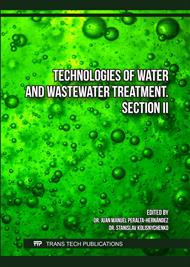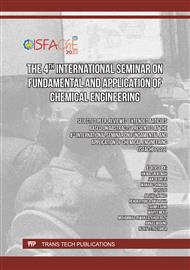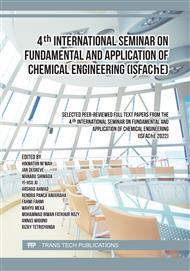[1]
S. Routray, R. Mohanty, R. Swain, S. Sahu, B.R. Mishra, Preparation and Characterisation of Zirconia Nano-materials Prepared From Zircon Minerals of Brahmagiri Coast, Journal of The Institution of Engineers (India): Series E 102(1) (2021) 87-95.
DOI: 10.1007/s40034-020-00201-1
Google Scholar
[2]
D. Yuhelda, S. Nuryadi, P. Pramusanto, Semi-Stable Zirconia made from zircon sand in Central Kalimantan by using a mixture of CaO and MgO stabilizers, Journal of Mineral and Coal Technology 6(3) (2010) 146-155.
Google Scholar
[3]
F. Ciesielczyk, W. Szczekocka, K. Siwińska-Stefańska, A. Piasecki, D. Paukszta, T. Jesionowski, Evaluation of the photocatalytic ability of a sol-gel-derived MgO-ZrO2 oxide material, Open Chemistry, 2017, p.7.
DOI: 10.1515/chem-2017-0002
Google Scholar
[4]
H. Cui, Q. Li, S. Gao, J.K. Shang, Strong adsorption of arsenic species by amorphous zirconium oxide nanoparticles, Journal of Industrial and Engineering Chemistry 18(4) (2012) 1418-1427.
DOI: 10.1016/j.jiec.2012.01.045
Google Scholar
[5]
C. Hang, Q. Li, S. Gao, J.K. Shang, As(III) and As(V) Adsorption by Hydrous Zirconium Oxide Nanoparticles Synthesized by a Hydrothermal Process Followed with Heat Treatment, Industrial & Engineering Chemistry Research 51(1) (2012) 353-361.
DOI: 10.1021/ie202260g
Google Scholar
[6]
J. Luo, X. Luo, C. Hu, J.C. Crittenden, J. Qu, Zirconia (ZrO2) Embedded in Carbon Nanowires via Electrospinning for Efficient Arsenic Removal from Water Combined with DFT Studies, ACS Applied Materials & Interfaces 8(29) (2016) 18912-18921.
DOI: 10.1021/acsami.6b06046
Google Scholar
[7]
A. Del Tedesco, V. Piotto, G. Sponchia, K. Hossain, L. Litti, D. Peddis, A. Scarso, M. Meneghetti, A. Benedetti, P. Riello, Zirconia-Based Magnetoplasmonic Nanocomposites: A New Nanotool for Magnetic-Guided Separations with SERS Identification, ACS Applied Nano Materials 3(2) (2020) 1232-1241.
DOI: 10.1021/acsanm.9b01982
Google Scholar
[8]
L. Keerthana, C. Sakthivel, I. Prabha, MgO-ZrO2 mixed nanocomposites: fabrication methods and applications, Materials Today Sustainability 3-4 (2019) 100007.
DOI: 10.1016/j.mtsust.2019.100007
Google Scholar
[9]
A. Majedi, F. Davar, A. Abbasi, Citric acid-silane modified zirconia nanoparticles: Preparation, characterization and adsorbent efficiency, Journal of Environmental Chemical Engineering 6(1) (2018) 701-709.
DOI: 10.1016/j.jece.2017.12.059
Google Scholar
[10]
K. Wang, W. Gao, F. Chen, G. Liu, J. Wu, N. Liu, Y. Kawabata, X. Guo, Y. He, P. Zhang, G. Yang, N. Tsubaki, Hierarchical nano-sized ZnZr-Silicalite-1 multifunctional catalyst for selective conversion of ethanol to butadiene, Applied Catalysis B: Environmental 301 (2022) 120822.
DOI: 10.1016/j.apcatb.2021.120822
Google Scholar
[11]
Y. Zhou, W. Song, L. Zhang, S. Tao, Preparation of hollow magnetic porous zirconia fibers as effective catalyst carriers for Fenton reaction, Journal of Materials Chemistry A 6(26) (2018) 12298-12307.
DOI: 10.1039/c8ta01286e
Google Scholar
[12]
S. Zolfagharinia, E. Kolvari, N. Koukabi, M.M. Hosseini, Core-shell zirconia-coated magnetic nanoparticles offering a strong option to prepare a novel and magnetized heteropolyacid based heterogeneous nanocatalyst for three- and four-component reactions, Arabian Journal of Chemistry 13(1) (2020) 227-241.
DOI: 10.1016/j.arabjc.2017.04.004
Google Scholar
[13]
H.R. Rajabi, H. Arjmand, S.J. Hoseini, H. Nasrabadi, Surface modified magnetic nanoparticles as efficient and green sorbents: Synthesis, characterization, and application for the removal of anionic dye, Journal of Magnetism and Magnetic Materials 394 (2015) 7-13.
DOI: 10.1016/j.jmmm.2015.06.024
Google Scholar
[14]
A.M. El Nahrawy, B.A. Hemdan, A.M. Mansour, A. Elzwawy, A.B. AbouHammad, Structural and Opto-Magnetic Properties of Nickel Magnesium Copper Zircon Silicate Nano-Composite for Suppress the Spread of Foodborne Pathogenic bacteria, Silicon (2021).
DOI: 10.1007/s12633-021-01295-x
Google Scholar
[15]
W. Fang, Z. Wang, Q. Xie, Y. Liu, D. Wu, Formation of Fe3O4@ZrO2 nanocomposite and its performance as a magnetic adsorbent for phosphate uptake: Influences of end-point pH and stirring rate during synthesis process, Chemical Engineering Research and Design 145 (2019) 194-202.
DOI: 10.1016/j.cherd.2019.03.013
Google Scholar
[16]
A. Ameen Hezam Saeed, N. Yub Harun, M. Mahmoud Nasef, A. Al-Fakih, A. Abdulhakim Saeed Ghaleb, H. Kolawole Afolabi, Removal of cadmium from aqueous solution by optimized rice husk biochar using response surface methodology, Ain Shams Engineering Journal 13(1) (2022) 101516.
DOI: 10.1016/j.asej.2021.06.002
Google Scholar
[17]
X.-R. Ma, X.-Y. Wei, R. Dang, W. Guo, Y.-H. Kang, X. Li, Y. Gao, J.-J. Bai, Y. Zhang, Z.-F. Zhang, Y.-J. Ma, Z.-M. Zong, A simple, environmentally friendly synthesis of recyclable magnetic γ-Fe2O3/Cd2+-Ni2+-Fe3+-CO32− layered double hydroxides for the removal of fluoride and cadmium ions. Adsorption capacity and the underlying mechanisms, Applied Clay Science 211 (2021) 106191.
DOI: 10.1016/j.clay.2021.106191
Google Scholar
[18]
K. Suzuki, T. Kato, S. Fuchida, C. Tokoro, Removal mechanisms of cadmium by δ-MnO2 in adsorption and coprecipitation processes at pH 6, Chemical Geology 550 (2020) 119744.
DOI: 10.1016/j.chemgeo.2020.119744
Google Scholar
[19]
X. Zhang, Y. Xue, J. Gao, C. He, Y. Ji, Y. Dou, Comparison of adsorption mechanisms for cadmium removal by modified zeolites and sands coated with Zn-layered double hydroxides, Chemical Engineering Journal 380 (2020) 122578.
DOI: 10.1016/j.cej.2019.122578
Google Scholar
[20]
WHO, Cadmium in Drinking-water, Fourth Edition ed., World Health Organization Press, Geneva, Swiss, 2011.
Google Scholar
[21]
C. Irawan, M.D. Putra, H. Wijayanti, R. Juwita, Y. Meliana, I.F. Nata, The Amine Functionalized Sugarcane Bagasse Biocomposites as Magnetically Adsorbent for Contaminants Removal in Aqueous Solution, Molecules 26(19) (2021) 5867.
DOI: 10.3390/molecules26195867
Google Scholar
[22]
M. Alsuhybani, A. Alshahrani, M. Algamdi, A.A. Al-Kahtani, A.A. Alqadami, Highly efficient removal of Pb(II) from aqueous systems using a new nanocomposite: Adsorption, isotherm, kinetic and mechanism studies, Journal of Molecular Liquids 301 (2020) 112393.
DOI: 10.1016/j.molliq.2019.112393
Google Scholar




